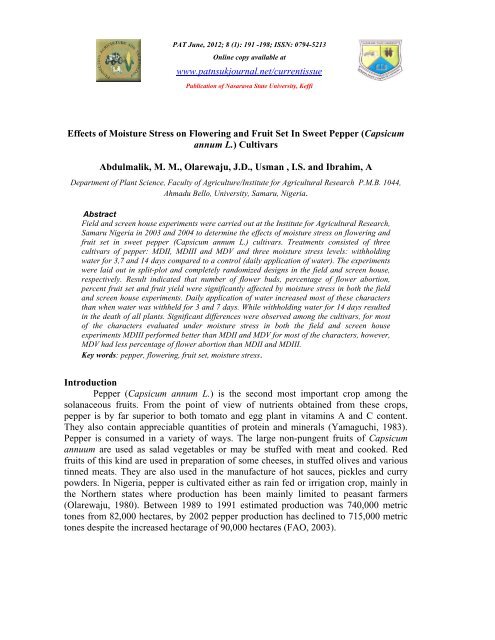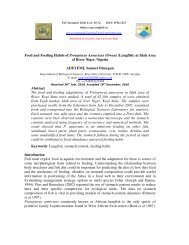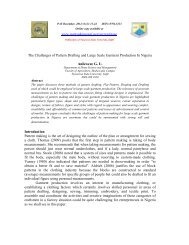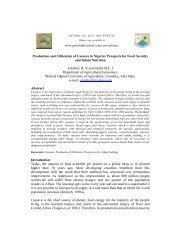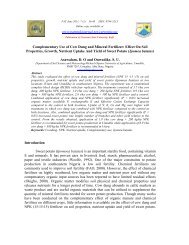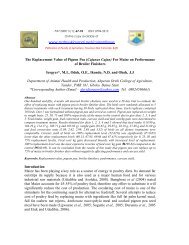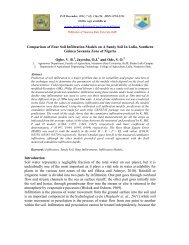View Publication - Production Agriculture and Technology Journal
View Publication - Production Agriculture and Technology Journal
View Publication - Production Agriculture and Technology Journal
- No tags were found...
Create successful ePaper yourself
Turn your PDF publications into a flip-book with our unique Google optimized e-Paper software.
PAT June, 2012; 8 (1): 191 -198; ISSN: 0794-5213Online copy available atwww.patnsukjournal.net/currentissue<strong>Publication</strong> of Nasarawa State University, KeffiEffects of Moisture Stress on Flowering <strong>and</strong> Fruit Set In Sweet Pepper (Capsicumannum L.) CultivarsAbdulmalik, M. M., Olarewaju, J.D., Usman , I.S. <strong>and</strong> Ibrahim, ADepartment of Plant Science, Faculty of <strong>Agriculture</strong>/Institute for Agricultural Research P.M.B. 1044,Ahmadu Bello, University, Samaru, Nigeria.AbstractField <strong>and</strong> screen house experiments were carried out at the Institute for Agricultural Research,Samaru Nigeria in 2003 <strong>and</strong> 2004 to determine the effects of moisture stress on flowering <strong>and</strong>fruit set in sweet pepper (Capsicum annum L.) cultivars. Treatments consisted of threecultivars of pepper: MDII, MDIII <strong>and</strong> MDV <strong>and</strong> three moisture stress levels: withholdingwater for 3,7 <strong>and</strong> 14 days compared to a control (daily application of water). The experimentswere laid out in split-plot <strong>and</strong> completely r<strong>and</strong>omized designs in the field <strong>and</strong> screen house,respectively. Result indicated that number of flower buds, percentage of flower abortion,percent fruit set <strong>and</strong> fruit yield were significantly affected by moisture stress in both the field<strong>and</strong> screen house experiments. Daily application of water increased most of these charactersthan when water was withheld for 3 <strong>and</strong> 7 days. While withholding water for 14 days resultedin the death of all plants. Significant differences were observed among the cultivars, for mostof the characters evaluated under moisture stress in both the field <strong>and</strong> screen houseexperiments MDIII performed better than MDII <strong>and</strong> MDV for most of the characters, however,MDV had less percentage of flower abortion than MDII <strong>and</strong> MDIII.Key words: pepper, flowering, fruit set, moisture stress.IntroductionPepper (Capsicum annum L.) is the second most important crop among thesolanaceous fruits. From the point of view of nutrients obtained from these crops,pepper is by far superior to both tomato <strong>and</strong> egg plant in vitamins A <strong>and</strong> C content.They also contain appreciable quantities of protein <strong>and</strong> minerals (Yamaguchi, 1983).Pepper is consumed in a variety of ways. The large non-pungent fruits of Capsicumannuum are used as salad vegetables or may be stuffed with meat <strong>and</strong> cooked. Redfruits of this kind are used in preparation of some cheeses, in stuffed olives <strong>and</strong> varioustinned meats. They are also used in the manufacture of hot sauces, pickles <strong>and</strong> currypowders. In Nigeria, pepper is cultivated either as rain fed or irrigation crop, mainly inthe Northern states where production has been mainly limited to peasant farmers(Olarewaju, 1980). Between 1989 to 1991 estimated production was 740,000 metrictones from 82,000 hectares, by 2002 pepper production has declined to 715,000 metrictones despite the increased hectarage of 90,000 hectares (FAO, 2003).
PAT 2012; 8 (1): 191-198: ISSN: 0794-5213 Abdulmalik et al,: Effects of Moisture Stress on Flowering …193(18% P 2 0 5 ) was applied before transplanting. While 65kg/ha of urea (46%N) wasapplied as top dressing at equal split dosage, 3 <strong>and</strong> 6 weeks after transplanting as sidedressing. Hoe weeding was done fortnightly two weeks after transplanting untilmaturity <strong>and</strong> cymbush at 50m1/10L of water was sprayed fortnightly against insectinfestation.Initially, the plants were watered uniformly <strong>and</strong> soil moisture contentmaintained at field capacity. Moisture stress treatment commenced 4 weeks aftertransplanting (WAT) <strong>and</strong> this was terminated at fruit maturity. Harvesting of fruitsstarted 12 WAT.Screen House Experiment <strong>and</strong> TechniqueScreen house experiment was carried out as follows: The 12 treatmentcombinations (i.e four moisture stress levels x three pepper cultivars) were laid out onscreen house benches in a completely r<strong>and</strong>omized design (CRD) repeated three times.Plastic pots measuring 20.3cm in diameter were filled with about 5kg of air dry soil,which was collected from the site, used for field experiment, to obtain uniformity in soilproperties <strong>and</strong> 5cm was left to the brim to allow for watering. A total of 72 pots wereused, this was to allow for destructive sampling. Fertilizer at the rate of 45kg/ha ofsingle super phosphate (18%) was applied after potting <strong>and</strong> the pots were watered tofield capacity. Seeds of pepper cultivars were first sown on nursery bed on 3 rd May2004 <strong>and</strong> transplanted to pots at 5WAS. Three seedlings were transplanted per pot <strong>and</strong>on establishment were thinned to one per pot. Normal stress treatment were carried outas done in the field experiment. Data on number of flowers, flower abortion, fruitset <strong>and</strong>fruit yield were recorded the data collected were subjected to analysis of varianceANOVA as described by Snedecor <strong>and</strong> Cochran (1967). Treatment means werecompared using Duncan’s Multiple Range Test (Duncan, 1955).Result <strong>and</strong> DiscussionThe number of flower buds/plant was significantly influenced by moisture stressin both the field <strong>and</strong> screen house experiments (Table 3). Daily application of water hadgreater number of flower buds/plant than when water was with held for 3 <strong>and</strong> 7 daywhile withholding water for 14 days resulted in the death of all plants. In pepper plantany increase in the rate of production of successive branches means that the number offlower buds formed will be increased. Therefore, the increased number of flower budsdue to daily application of water could be attributed to the more rapid formation ofbranches as suggested by Olarewaju (1980). The deaths of plants as a result ofwithholding water for 14 days could be due to prolong dehydration. Cultivarsdifferences in the number of flower buds/plant were observed only in the field (Table
PAT 2012; 8 (1): 191-198: ISSN: 0794-5213 Abdulmalik et al,: Effects of Moisture Stress on Flowering …1943). The highest number of flower buds was obtained from MDIII then MDII <strong>and</strong> MDV;this could be attributed to tolerance to moisture stress of the cultivar.Moisture stress significantly increased flower abortion in the drier regimescompared to daily application of water treatment in both the field <strong>and</strong> screen houseexperiment (Table 4) the increased flower abortion could be due to reducedphotosynthetic rate <strong>and</strong> increased abscisic acid concentration under moisture stress. Dryregimes have been reported to increase flower abortion (Olarewaju, 1980) similarsuggestion was made by Bosl<strong>and</strong> <strong>and</strong> Votava (2000) that blossoms of water stressedpepper plants often drop. Cultivars differ in the percentage of flower abortion in boththe field <strong>and</strong> screen house experiment (Table 4). Among the cultivars evaluated MDVrecorded the least percentage of flower aborted/plant in comparison to MDIII <strong>and</strong>MDII. This could be due to tolerance to moisture stress of the cultivar.Percent fruit set was significantly increased by daily application of water thanwhen water was with held for 3 <strong>and</strong> 7 days in both the field <strong>and</strong> screen houseexperiment (Table 5) the decreased in fruit set under moisture stress could be attributedto increased abscisic acid (ABA) concentration in the reproductive structures as a resultof moisture stress. This has been suggested to play a role in determining grain set inmaize (Ober et al., 1991; Artlip et al., 1995). No significant cultivar differences wereobserved in both the field <strong>and</strong> screen house experiment in fruit set (Table 5).The fruit yield of pepper was significantly influence by moisture stress in boththe field <strong>and</strong> screen house experiment (Table 6). There was less fruit yield in the drierregimes than in daily application of water treatment. The apparent marked reduction infruit yield could be attributed to restricted fruit set caused by dehydration <strong>and</strong> reducedassimilate partitioning. Alvino et al. (1994) reported that when moisture was abundant,higher percentage of large, heavy, marketable fruits were formed. Variation inperformance was observed among the cultivars in fruit yield produced per plant in boththe field <strong>and</strong> screen house experiment (Table 6). Generally, the cultivars evaluated hereperformed poorly under moisture stress for fruit yield. However, fruit yield from MDIIIwas higher than that obtained from MDII <strong>and</strong> MDV, this could be attributed to geneticinfluence.The results obtained from this study, indicated that the characters evaluatedwere more affected by moisture stress in the screen house than in the field. Hightemperature could be the reason for this observed difference. At high temperature manyof the flowers formed, were aborted (Rylski <strong>and</strong> Halevy, 1974) <strong>and</strong> fruit set was alsoadversely affected (Olarewaju, 1980).
PAT 2012; 8 (1): 191-198: ISSN: 0794-5213 Abdulmalik et al,: Effects of Moisture Stress on Flowering …195ConclusionThe result of this study clearly shows that moisture stress significantly affectedflowering, fruit set <strong>and</strong> fruit yield of pepper. It can therefore be concluded that adequatemoisture is necessary for maximum fruit yield of pepper. Similarly, in view of thedeclining trend in the annual rainfall of Nigeria, drought tolerant varieties will greatlyimprove production of pepper. Therefore improvement on cultivars MDIII <strong>and</strong> MDVcould be of great benefit to our farmers.ReferenceAlvino, A. Certritto, M. <strong>and</strong> De Lerenzi, F. (1994). Photosynthesis response of sunlight<strong>and</strong> shade pepper (Capsicum annuum) leaves at different positions in the canopyunder two water regimes. Aust.J. Plant Physiol. 21:377-391.Artlip, T.S. Madison, J.T. <strong>and</strong> Setter, T.L. (1995). Water deficit in developingendosperm of maize: Cell division <strong>and</strong> nuclear endorepduplication. Plant cellEnviron 18:1034- 1040.Bosl<strong>and</strong>, P.W. <strong>and</strong> Votava, E.J. (2000). Pepper: Vegatable <strong>and</strong> Spice Capsicums. CABIPublishing, New York.Bray, E.A. (1997). Plant responses to water deficit. Trends Plant Sci. 2:48-54.Cochran, H.L. (1936). Some factors influencing growth <strong>and</strong> fruit-setting in the pepper(Capsicum frutescence L.) Cornell Univ. Agric. Exp. Stat. Memoir 190.pp.1-39.Dagdelen, N. Yilmaz, E. Sezg Yn, F. <strong>and</strong> Gurbuz, T. (2004). Effects of water stress atdifferent growth stages on processing pepper (Capsisum annuum cv. Kapija)yield, water use <strong>and</strong> quality characteristic. Pak. J. Biol. Sci. 7(12): 2167-2172.Duncan, D.B. (1955). Multiple Range <strong>and</strong> Multiple F-test. Biometrics. 11:1-42.FAO, (2003). FAO bulletin of statistics, Rome Italy. 4 (2):98-99.Minges, P.A. <strong>and</strong> Warholic, D. (1973). Pepper Problems in New York. 1:14, In:Proc.Natl. Pepper Conf. Packers Intl., St. Charles, U.S.A.Ober, E.S. Setter, T.L. Madison, J.T. Thomson, J.F. <strong>and</strong> Shapiro, P.S. (1991). Influenceof water deficit on maize endosperm development. Enzyme activities <strong>and</strong> RNAtranscripts of starch <strong>and</strong> zeinsynthesis, abscisic acid <strong>and</strong> cell division. PlantPhysiol. 97:154-164.Olarewaju, J.D. (1980). Effects of environment on flowering <strong>and</strong> fruit set in sweetpepper (Capsicum annuum L.). Unpublished Ph.D. Dissertation University ofReading.Rylski, I. <strong>and</strong> Halevy, A.H. (1974). Optimal environment for set <strong>and</strong> development ofsweet pepper fruit. Acta Hortic. 42:55-62.Shaib, B. Aliyu, A. <strong>and</strong> Bakshi, J.S. (1997). Nigeria: National Agricultural ResearchStrategy Plan. 1996-2010. Dept. Agric Sci. Fed. Min. Agric <strong>and</strong> Natural
PAT 2012; 8 (1): 191-198: ISSN: 0794-5213 Abdulmalik et al,: Effects of Moisture Stress on Flowering …196Resources, Abuja Nigeria. pp. 42.Snedecor, G.W. <strong>and</strong> Cochran, W.G. (1967). Statistical methods . 6 th edition, Iowa StateUniversity Press, Iowa, U.S.A. pp.607.Wien, H.C. Tripp, K.E. Hern<strong>and</strong>ez-Armenta, R. <strong>and</strong> Turner, A.D. (1989). Abscission ofreproductive structures in pepper: Causes, Mechanisms <strong>and</strong> Control. pp.150-165In: Tomato <strong>and</strong> Pepper <strong>Production</strong> in the Tropics. S.K. Green (ed). AsianVegetable Res. <strong>and</strong> Develop. Ctr. Shanhua, Taiwan.Wien, H.C. (1990). Screening pepper cultivars for resistance to flower abscission: Acomparison of techniques. Hort. Science 25:1634-1636.Yamaguchi, M. (1983). World Vegetables, Principles <strong>and</strong> Nutritive Values. The AviPubl. Com.Inc., West Port, Connecticut pp.303-306.Table 1: Total rainfall (mm), mean temperature ( 0 C) <strong>and</strong> mean relative humidity (%) atten days interval during the field experiment in 2003/04 at Samaru.Months days Rainfall (mm) Max Temp Min.Temp Relative( 0 C) ( 0 C) humidity (%)September 1-10 11:1 29.8 22.0 84.111-20 7.6 30.1 22.0 81.321-30 3.2 32.1 22.6 71.8October 1-10 2.9 31.6 22.8 69.811-20 4.8 32.1 22.5 74.021-31 - 34.7 21.0 68.5November 1-10 - 33.8 20.6 40.211-20 - 33.7 18.5 21.821-30 - 33.1 16.1 17.1December 1-10 - 32.5 15.3 14.811-20 - 32.1 16.0 22.421-31 - 29.0 15.5 17.3January 1-10 - 32.7 17.6 18.411-20 - 30.8 15.1 12.421-31 - 32.1 14.5 12.2Source: Meteorological Unit, Institute for <strong>Agriculture</strong> Research, Samaru
PAT 2012; 8 (1): 191-198: ISSN: 0794-5213 Abdulmalik et al,: Effects of Moisture Stress on Flowering …197Table 2: Total rainfall (mm), mean temperature (0C) <strong>and</strong> mean relative humidity (%) at ten days intervalduring the screen house experiment in 2004 at Samaru.Months days Rainfall (mm) Max. Temp Min Temp Relative( 0 C) ( 0 C) humidity (%)May 1-10 1.2 36.3 23.6 62.311-20 5.9 34.5 22.7 64.921-30 3.9 33.0 22.1 71.2June 1-10 4.6 31.3 20.6 74.811-20 9.2 32.5 20.3 77.621-30 5.3 30.4 20.2 80.5July 1-10 8.1 31.2 20.3 74.211-20 8.5 30.2 20.3 78.021-31 7.2 29.6 20.0 81.6August 1-10 11.5 29.5 21.0 84.511-20 9.3 29.3 20.6 84.821-31 9.1 29.5 19.6 82.7September 1-10 6.8 30.8 20.2 79.611-20 3.6 31.2 20.1 78.921-30 2.3 32.8 20.0 70.1Source: Meteorological Unit, Institute for <strong>Agriculture</strong> Research, SamaruTable 3:Effects of moisture stress <strong>and</strong> cultivar on number of flower buds/plant of pepper in field<strong>and</strong> screen house experiments.Treatment Field ScreenMoisture StressDaily application of water (Control) 37.98a 33.81a3 days watering regime 32.50b 27.97b7 days watering regime 17.32c 15.11c14 days watering regime NS NSSE+ 1.58 0.77CultivarMDII 21.72b 18.94bMDIII 22.55a 19.95aMDV 21.58b 18.78bSE+ 0.39 0.67Means followed by same letter(s) within a column are not significantly different at 5% level of significance using DMRTNS=None Survived
PAT 2012; 8 (1): 191-198: ISSN: 0794-5213 Abdulmalik et al,: Effects of Moisture Stress on Flowering …198Table 4: Effect of moisture stress <strong>and</strong> cultivar on percentage of flower abortion of pepper in thefield <strong>and</strong> screen house experiments.Treatment Field ScreenMoisture StressDaily application of water (Control) 5.86c 7.98c3 days watering regime 7.88b 12.58b7 days watering regime 24.25a 30.81a14 days watering regime NS NSSE+ 0.59 0.90CultivarMDII 10.86a 14.40aMDIII 9.93b 12.38bMDV 7.70c 11.74cSE+ 0.39 0.78Means followed by the same letter(s) within a column are not significantly different at 5% level of significance using DMRTNone Survived.Table 5: Effects of moisture stress <strong>and</strong> cultivar on percent fruit set per plant of pepper in field <strong>and</strong> screenhouse experiments.Treatment Field ScreenMoisture StressDaily application of water (Control) 27.47a 28.17a3 days watering regime 26.94a 24.68b7 days watering regime 17.91b 13.69c14 days watering regime NS NSSE+ 1.88 0.96CultivarMDII 18.33 15.90MDIII 19.40 17.55MDV 18.01 16.45SE+ 0.90 0.83Means followed by the same letter(s) within a column are not significantly different at 5% level of significance using DMRT.Ns=None Survived.Table 6: Effects of moisture stress <strong>and</strong> cultivar on fruit yield (kg/plant) of pepper in field <strong>and</strong> screenhouse experiments.Treatment Field ScreenMoisture StressDaily application of water (Control) 0.87a 0.64a3 days watering regime 0.66a 0.42b7 days watering regime 0.08b 0.05c14 days watering regime NS NSSE+ 0.02 0.02CultivarMDII 0.35c 0.22bMDIII 0.45a 0.31aMDV 0.41b 0.31aSE+ 0.01 0.02Means followed by the same letter(s) within a column are not significantly different at 5% level of significance using DMRT.Ns=None Survived.NS=


